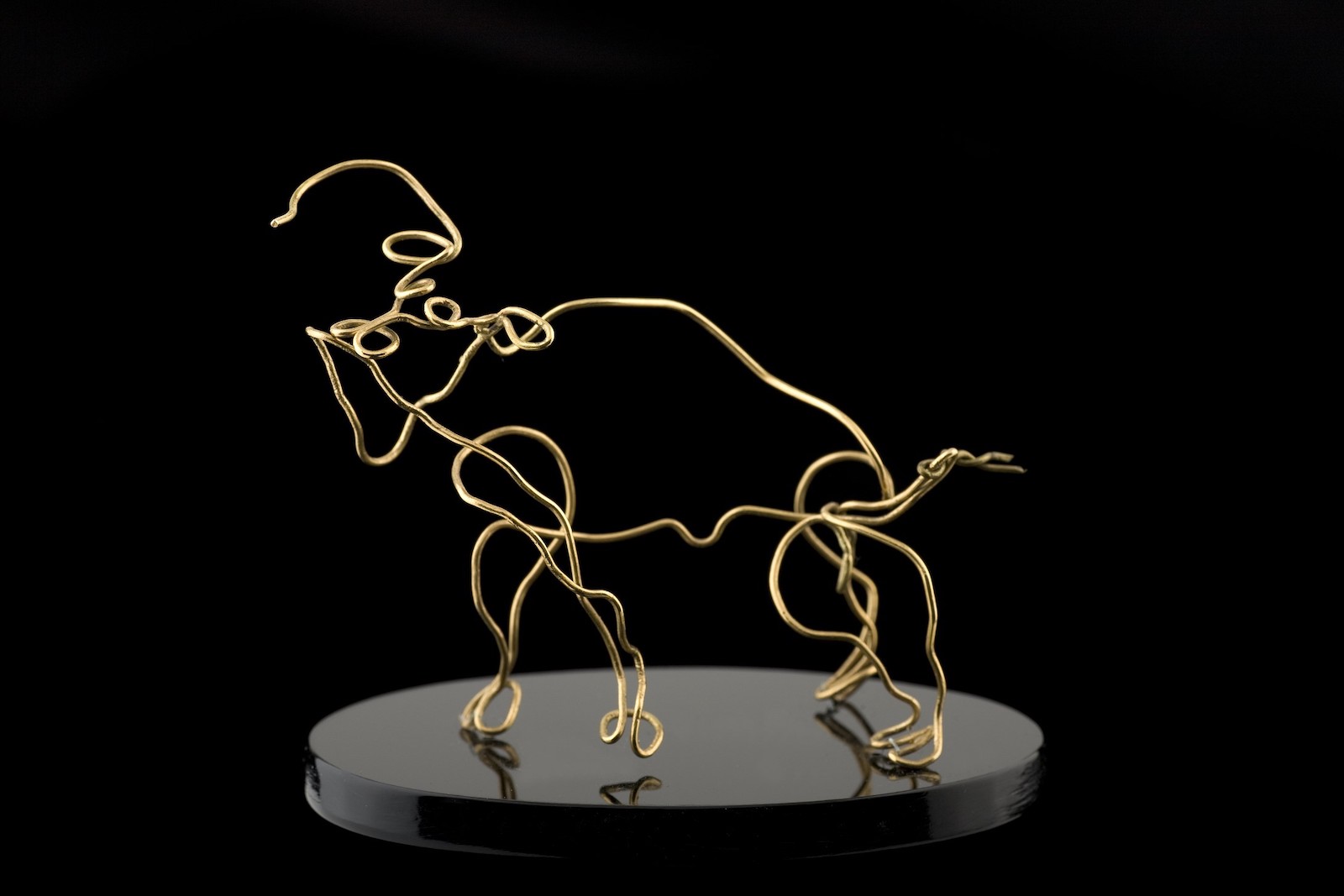“The whale saves children, and children are the future,” says Maynard Johnny Jr. We are looking at his colourful serigraph print entitled Protector, which shows an image of a child’s face and a killer whale. Orcas typically stay with the same pod, raising their young with care, he says. Protector reminds Indigenous people to protect young people and culture so that future generations will prosper. His circular work lights up the Bill Reid Gallery of Northwest Coast Art and captures the spirit of the “Bright Futures” exhibition, on view until January 2024. Fourteen emerging and established Northwest Coast artists submitted work to celebrate the legacy of Haida artist Bill Reid.
Raised in Victoria, B.C., Reid struggled with his sense of identity and connection. After he explored his maternal Haida roots as an adult, he went on to create a wide range of visual work, becoming an integral part of the 20th-century cultural revival of Northwest Coast art. In a 1967 essay on Indigenous art, he wrote, “These were objects of bright pride, to be admired in the newness of their crisply carved lines, the powerful flow of sure elegant curves and recesses—yes, and in the brightness of fresh paint.”
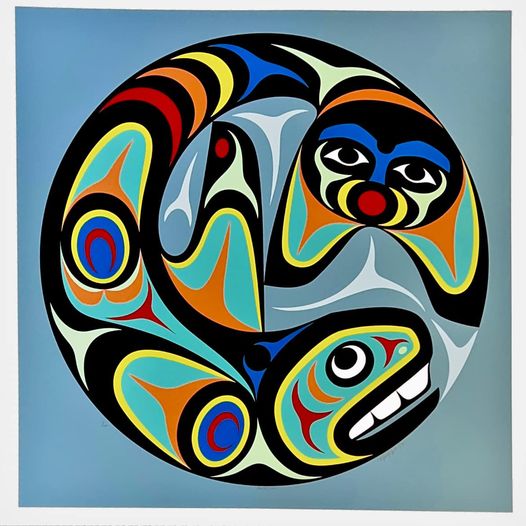
Protector by Maynard Johnny Jr., 2023. Silkscreen print.
More than 50 artists provided objects that demonstrate this bright pride, answering a call for works that speak to how Reid continues to influence contemporary Northwest Coast art. Each piece selected for the show is paired with a work by Reid from the gallery’s permanent collection.
Johnny is of Coast Salish and Kwakwaka’wakw descent and has been creating art in the Coast Salish style since the 1990s. Primarily self-taught, he studied geometric shapes such as the Salish spindle whorl with its three-pointed triangle, or trigon. The artist uses a wide palette of colours, in a break from the traditional black and red. “Colour is cheerful,” Johnny says. Protector is twinned with Reid’s serigraph print Children of the Raven.
“Native art is important,” Johnny believes. “We have survived residential school, the potlatch ban, the ’60s Scoop, and the Indian Act, which still exists. Our Elders weren’t allowed to bring our culture to light.”
The show’s range of art demonstrates innovation, experimentation, and subversive messaging. “We were looking for the new and traditional,” co-curator Beth Carter says. “Some of the pieces are in direct conversation with Reid’s work. Other artists were influenced in a more general way.”
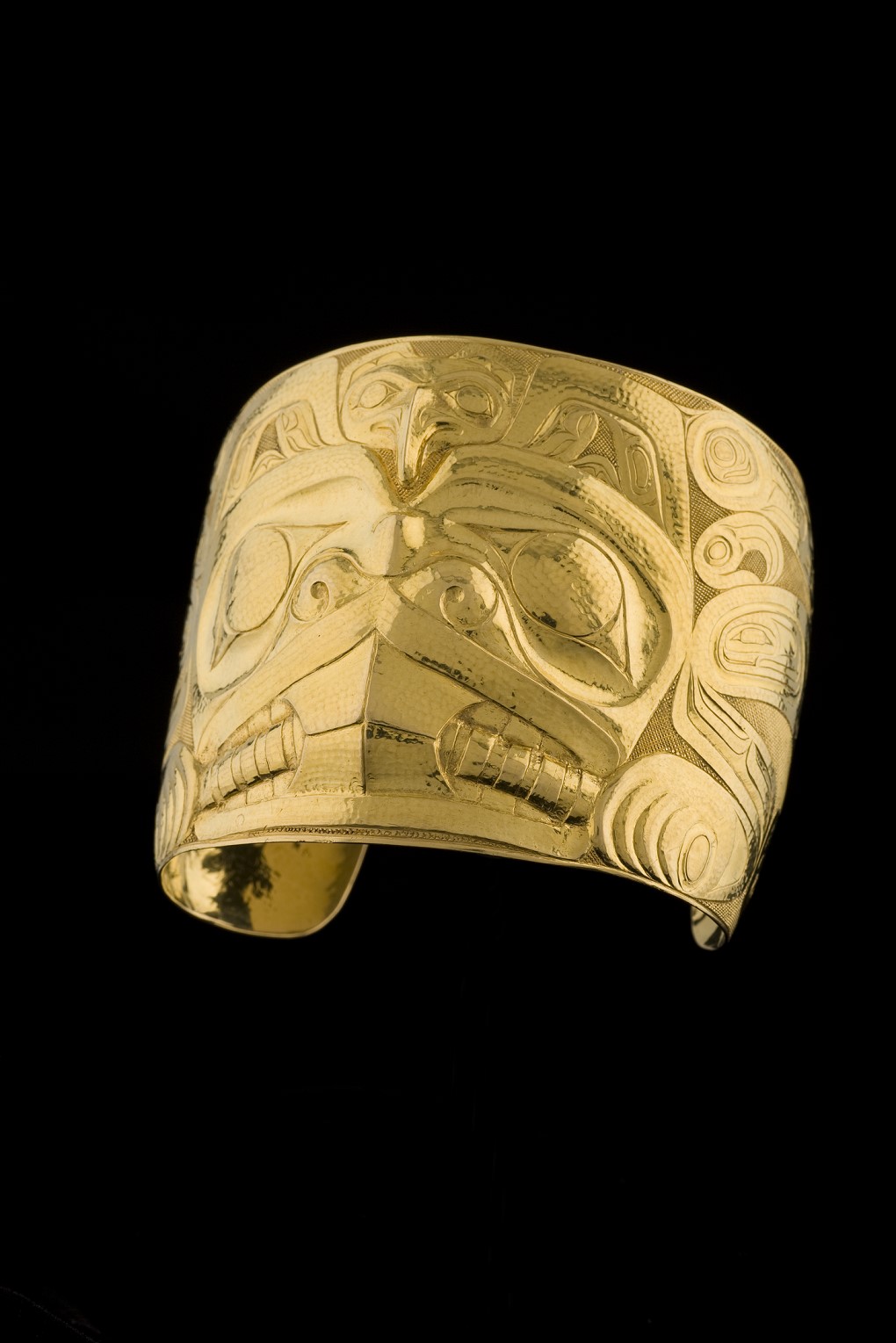
Beaver and Eagle Bracelet by Bill Reid, 1970. 22K gold. Simon Fraser University Bill Reid Collection 2006.1.2.1. Gift of Anton and Hildegard Cavelti. Photo by Kenji Nagai.
Stealing the Light, a collaboration between Dustin Sheldon (Teslin Tlingit) and Krystle Silverfox (Selkirk and Northern Tutchone), is a series of quirky form-line images created by using long-exposure black-and-white digital photography. The images echo Reid’s playful three-dimensional wire figures.
A large acrylic painting by Cody Lecoy (Sylix/Lekwungen) titled Against the Current presents several dream-like images, including a pool of green liquid. Surrealism, part of the European tradition of abstract painting, is Lecoy’s preferred form of expression. “This has allowed me to portray qualities of the interior life and the exterior environment within the same plane of the canvas,” he writes. His painting honours Reid’s The Spirit of Haida Gwaii, featured on the $20 Canadian banknote.
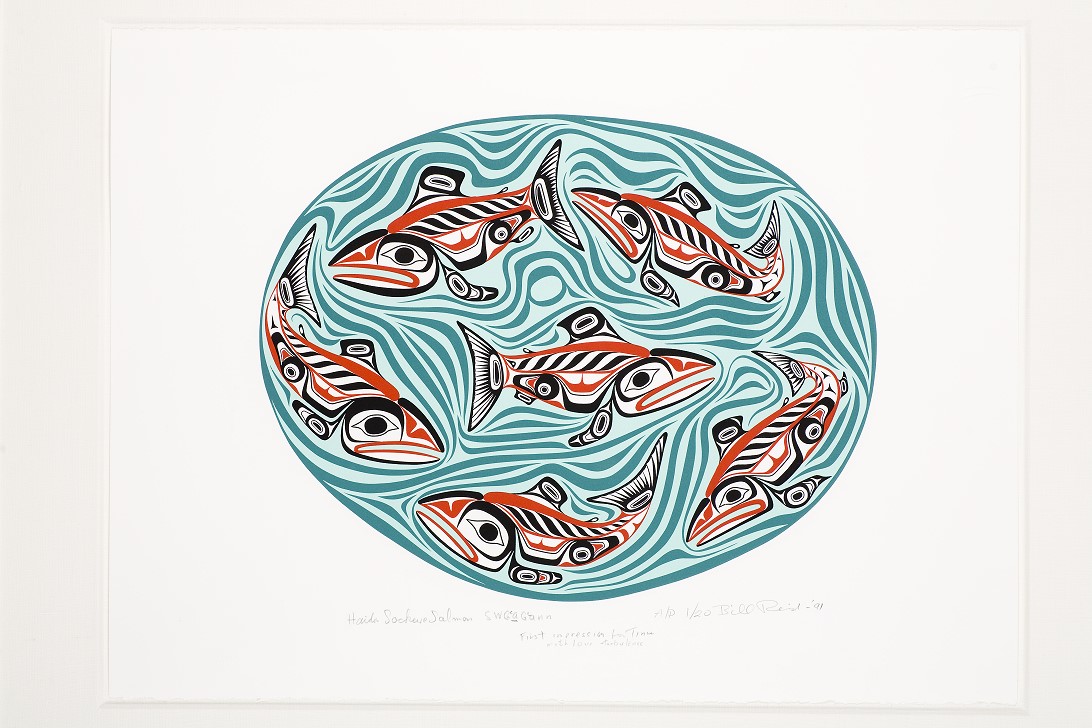
Swg’ag’an Sockeye Salmon Pool by Bill Reid, 1991. Serigraph on paper. Simon Fraser University Bill Reid Collection, 2002.1.43. Photo by Kenji Nagai.
Haida artist Tamara Rain Bull’s Reconciled Bills also engages with the images on our money, transforming 40 portraits of Canadian and American political leaders on government-issued currency into images of Indigenous men and women. She used crayons and watercolours to create the second series of portraits overtop of the originals.
Transformation is also a theme in Shoshannah Greene’s canvas Raven in the City, created with gouache on watercolour board. The painting depicts a young man in contemporary dress, sprouting with feathers and a beak as he gazes at graffiti of a raven on an alley wall. He is transforming into the Raven, a trickster character, Greene says, a Haida myth also prominent in Reid’s art.
Greene, as with Reid, is of mixed Haida and European heritage. She was 18 years old when she moved to Vancouver from the village of Cumshaw on Haida Gwaii to enrol in Emily Carr University of Art and Design. She dreamed of becoming an animator at Walt Disney Studios. Everything shifted in third year, she says, when she began exploring her maternal Indigenous roots. After graduating from art school in 2015, she learned more about the Haida form line, both traditional and contemporary, while working in museums. “I studied the intention and flow within the forms,” she says.
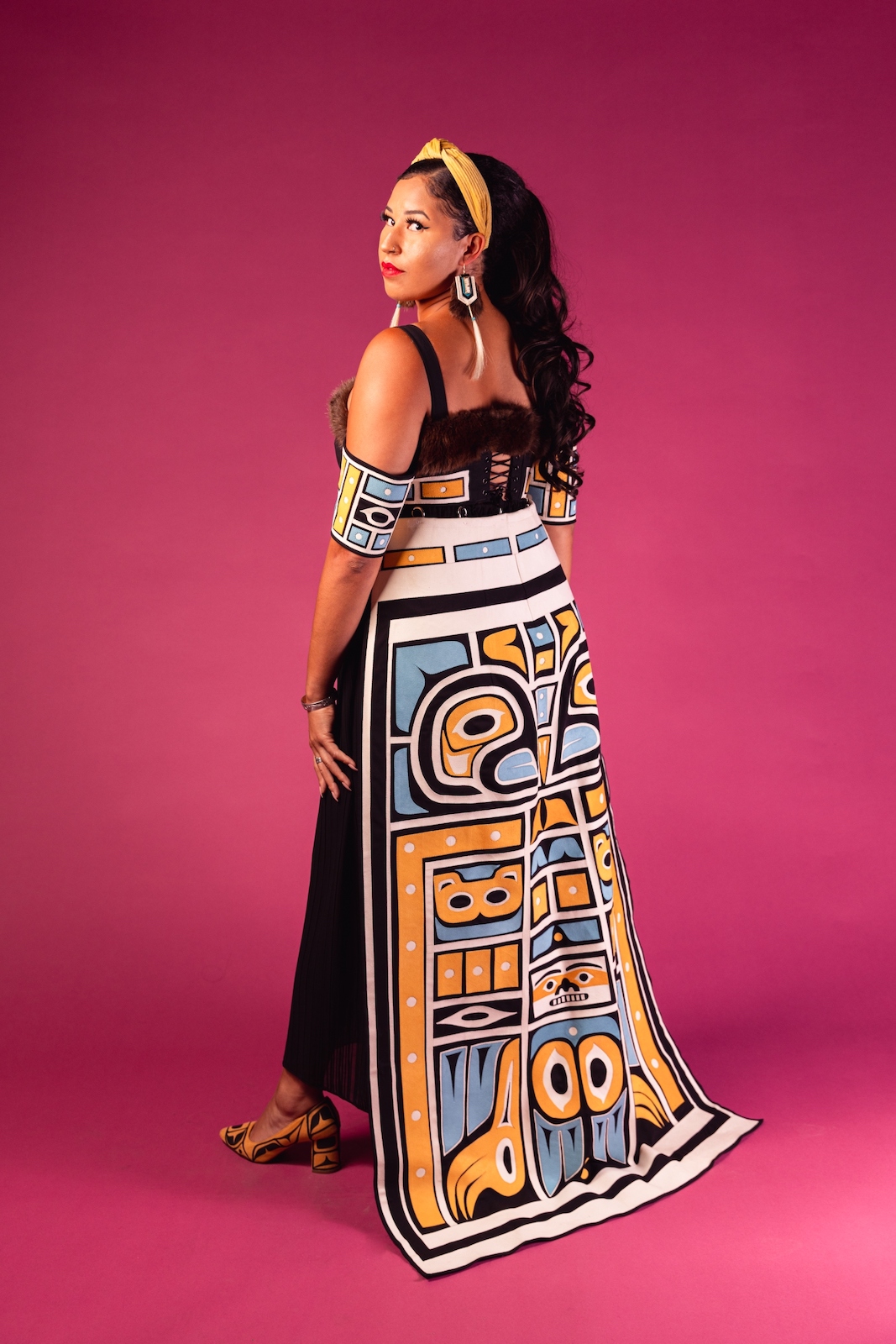
Chilkat Dress and Eagle Train by Yolonda Skelton, 2022. Pleated chiffon and ponte dress with beaver fur trim, ultrasuede appliqued cuffs, removable wool suiting, appliqued eagle train. Photo courtesy of the artist.
Fabric art pieces in the show include a stunning dress with a train and sleeve cuffs by Gitxsan designer Yolonda Skelton titled Ancestral Threads, inspired by traditional Chilkat blankets. Sherri Dick, a Haida weaver whose work is most often used in traditional ceremonies, created an ancestor-face bag. Floral designs made of cedar rope are woven into a cape called Ancestral Strength by Rebecca Baker-Grenier (Kwag’ul/Squamish), decorated with wool, ermine, gold-plated beads, Swarovski crystals, and jingles—metal cones that produce a bell-like sound.
Calvin Morberg (Teslin Tlingit) created Eagle Hat, made of copper in the style of a traditional Tlingit spruce root hat. Remarkably, the artist hammered the work from a single flat sheet. To create raised images, he used a repousse technique originally developed by Reid. An ermine pelt attached at the crown tumbles down the hat’s side.
The Bill Reid Gallery, named in his honour, opened in 2008, and remains the only public gallery in Canada devoted to contemporary Indigenous art of the Northwest Coast. The fullness of Reid’s art and life emerges in this exhibition and shines a bright light on the artists thriving in his wake.
Read more stories about the arts.

